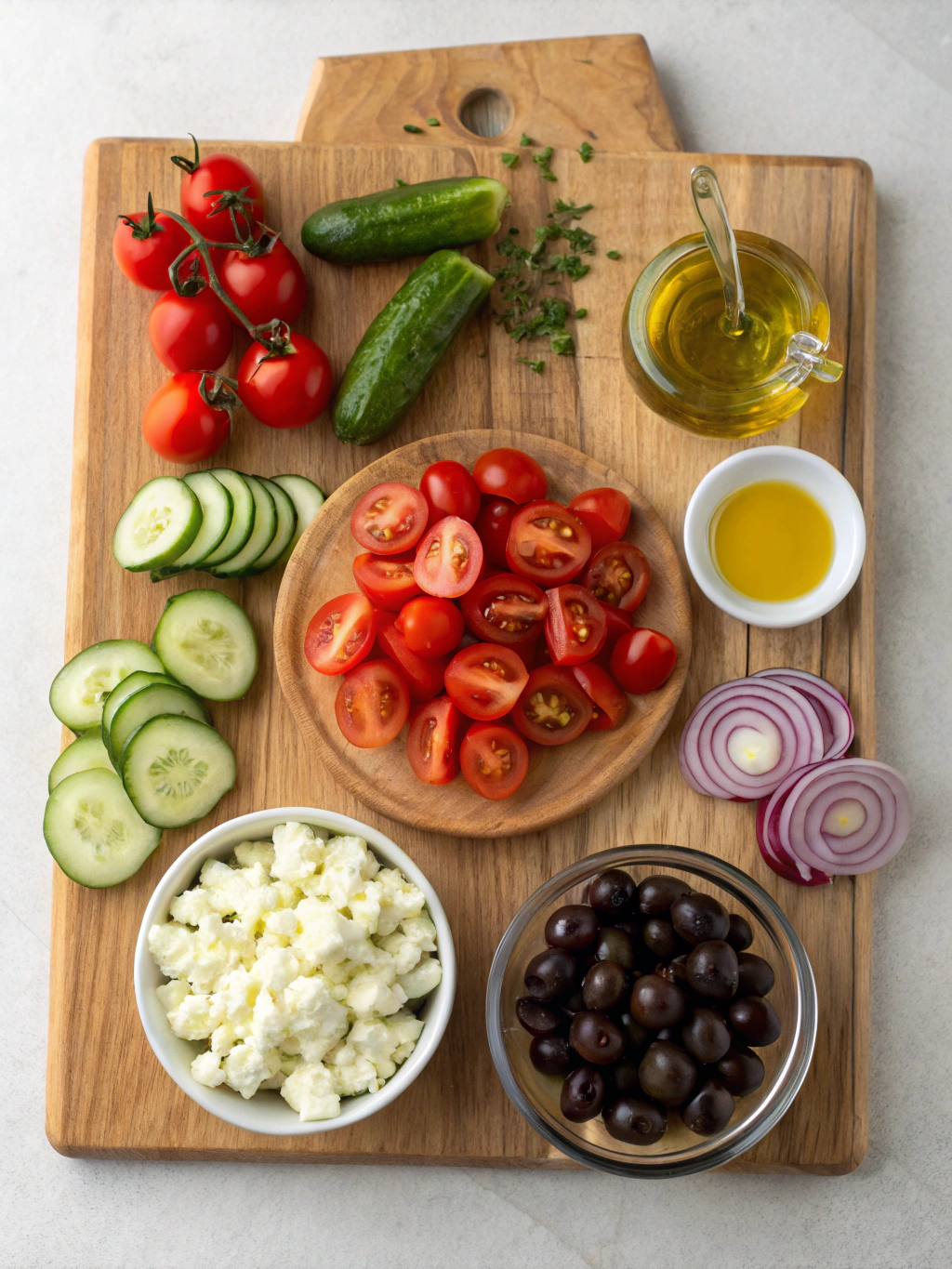Greek Salad Dressing
This vibrant homemade Greek salad dressing combines tangy lemon juice, quality olive oil, and aromatic herbs to create an authentic Mediterranean flavor that transforms ordinary salads into extraordinary meals in just 5 minutes.
Easy Greek Salad Dressing Recipe
There’s something magical about the perfect Greek salad dressing—that ideal balance of bright acidity, fruity olive oil, and aromatic herbs that transports you straight to a sun-drenched taverna overlooking the Aegean Sea. While store-bought versions can be convenient, nothing compares to the vibrant flavors of a homemade Greek salad dressing made with fresh ingredients. This classic recipe has been in my family for generations, refined over countless Sunday gatherings where Greek salads were always the centerpiece of our Mediterranean table.
Traditional Greek dressing is especially popular during summer months when garden herbs are abundant and fresh vegetables are at their peak, but the beauty of this recipe is its year-round versatility. Made with pantry staples and a few fresh ingredients, it brings Mediterranean sunshine to your table any day of the year.
THIS RECIPE:
- Authentic Greek flavors with just 8 simple ingredients
- Ready in 5 minutes with no special equipment needed
- Perfect balance of tangy and savory notes
- Keeps fresh in the refrigerator for up to 2 weeks
| Recipe Details | Information |
|---|---|
| Prep Time | 5 minutes |
| Cook Time | 0 minutes |
| Total Time | 5 minutes |
| Servings | Makes 1 cup (16 tablespoons) |
| Yield | Enough for 8-10 salads |
This homemade Greek salad dressing recipe is truly the epitome of simplicity meeting extraordinary flavor. With just a few minutes of preparation, you’ll create a versatile dressing that not only elevates traditional Greek salads but also works beautifully as a marinade for chicken or a flavorful drizzle over roasted vegetables. The best part? You likely already have most of the ingredients in your pantry!
Ingredients for Greek Salad Dressing
The secret to an exceptional Greek salad dressing lies in the quality of your ingredients. Since this recipe contains relatively few components, each one significantly impacts the final flavor. The foundation of any authentic Greek salad dressing is extra virgin olive oil—ideally one with Greek or Mediterranean origins that offers those characteristic peppery and fruity notes.
For the Greek Salad Dressing:
- ½ cup extra virgin olive oil
- ¼ cup red wine vinegar
- 2 tablespoons fresh lemon juice
- 1 teaspoon Dijon mustard
- 2 cloves garlic, minced (about 2 teaspoons)
- 1 teaspoon dried oregano (preferably Greek)
- ½ teaspoon dried basil
- 1 teaspoon honey or sugar (optional, for balancing acidity)
- ¾ teaspoon kosher salt
- ½ teaspoon freshly ground black pepper
- ¼ teaspoon dried dill (optional)
| Ingredient Category | Recommended Quantity | Quality Tips |
|---|---|---|
| Oils | ½ cup extra virgin olive oil | Choose cold-pressed, single-origin Greek or Mediterranean olive oil with a harvest date |
| Acids | ¼ cup red wine vinegar + 2 Tbsp fresh lemon juice | Use authentic red wine vinegar (not “red vinegar”) and freshly squeezed lemon juice |
| Aromatics | 2 cloves garlic + herbs | Fresh garlic is non-negotiable; dried Greek oregano offers the most authentic flavor |
| Emulsifiers | 1 tsp Dijon mustard | Traditional Dijon provides the perfect binding power without overwhelming flavor |
| Seasonings | Salt, pepper, optional sweetener | Kosher salt and freshly ground pepper make a noticeable difference in flavor profile |
Pro tip: When possible, crush the dried oregano between your fingers before adding it to the dressing. This simple step releases the essential oils and dramatically enhances the herb’s aromatic properties in your Greek salad dressing.
How to Make Greek Salad Dressing
Creating the perfect Greek salad dressing is all about proper emulsification—the process of suspending tiny droplets of oil within the vinegar to create a temporarily stable mixture. While this dressing will naturally separate over time (simply shake before using), proper initial emulsification ensures a smooth, well-blended dressing with evenly distributed flavors.
Prepare the base: In a medium bowl, whisk together the red wine vinegar, lemon juice, Dijon mustard, minced garlic, dried oregano, dried basil, salt, pepper, and honey (if using).
Create the emulsion: While whisking continuously, slowly drizzle in the olive oil in a thin stream. This gradual addition is key to proper emulsification.
Whisk until smooth: Continue whisking for about 30-60 seconds until the dressing looks creamy and well combined.
Taste and adjust: Sample your Greek salad dressing and adjust seasonings as needed. For more acidity, add extra vinegar or lemon juice; for more complexity, consider adding a pinch more dried herbs.
Rest for best flavor: While you can use this dressing immediately, allowing it to rest for at least 30 minutes (or ideally 2 hours) permits the flavors to fully develop and meld together.
Technical tip: If you prefer a smoother, more thoroughly emulsified dressing, you can blend all ingredients in a small food processor, blender, or use an immersion blender. This creates a temporarily thicker consistency that some prefer, though it’s not traditional.
Tips for Making Greek Salad Dressing
Getting your homemade Greek salad dressing just right means paying attention to a few key details that professional chefs always consider:
- Oil quality matters most: The olive oil constitutes half your dressing and provides the foundational flavor—this is not the place to economize.
- Balance is everything: The perfect ratio of oil to acid creates that signature tangy-but-smooth Greek dressing profile.
- Fresh garlic only: Pre-minced jarred garlic lacks the aromatic compounds that make fresh garlic so essential to authentic flavor.
- Let herbs hydrate: Dried oregano needs time to release its flavors into the oil—patience rewards you with deeper flavor.
| Technique | Recommendation | Why It Works |
|---|---|---|
| Emulsification | Whisk acid mixture first, then slowly add oil | Creates proper suspension of oil in vinegar for better coating ability |
| Garlic preparation | Mince very finely or use a microplane | Distributes garlic flavor evenly without overwhelming chunks |
| Temperature | Make and serve at room temperature | Cold temperatures mute flavors and solidify olive oil |
| Seasoning | Always slightly over-season | Salad ingredients dilute dressing once applied |
Pro tip: If you have an almost-empty mustard jar, make your dressing directly in it! Add all ingredients except oil, shake well, then add oil and shake again. This uses every bit of mustard and reduces cleanup.
Make-Ahead Instructions
One of the greatest virtues of homemade Greek salad dressing is how well it keeps and how the flavors continue to develop over time. In fact, many Greek cooks intentionally make this dressing in advance to allow the herbs and garlic to fully infuse into the oil.
To prepare Greek salad dressing ahead of time:
- Combine all ingredients as directed and transfer to an airtight container or glass bottle with a tight-fitting lid.
- Refrigerate for up to 2 weeks.
- Remove from refrigerator 30 minutes before serving, as cold temperatures cause the olive oil to solidify.
- Shake vigorously before each use to recombine ingredients that naturally separate.
This dressing actually improves after the first 24 hours as the dried herbs fully hydrate and release their essential oils into the mixture.
Storing Leftovers
Proper storage is essential for maintaining the quality and food safety of your homemade Greek salad dressing:
Store your Greek salad dressing in an airtight glass container in the refrigerator. While the acidic nature of the dressing inhibits bacterial growth, refrigeration is still recommended, especially since it contains fresh garlic. The dressing will keep well for up to 2 weeks when properly stored.
If you notice the olive oil has solidified in the refrigerator (which is normal), simply let the dressing sit at room temperature for 15-30 minutes before using. Always use clean utensils when dipping into your stored dressing to prevent contamination and extend shelf life.
Glass containers are preferable to plastic, as they won’t absorb the garlic odor or potentially leach chemicals into the acidic dressing.
Freezing Greek Salad Dressing
While you technically can freeze Greek salad dressing, I don’t recommend it for optimal quality. Freezing and thawing can alter the emulsion structure and flavor profile of the dressing. The garlic flavor sometimes becomes more pronounced or takes on metallic notes after freezing, and the texture of the dressing may not be as smooth when thawed.
If you must freeze your dressing:
- Pour into ice cube trays for convenient portioned servings.
- Freeze until solid, then transfer cubes to a freezer-safe container.
- Store frozen for up to 3 months.
- Thaw overnight in the refrigerator.
- Bring to room temperature and shake or whisk vigorously before using.
A better alternative to freezing is simply making smaller batches more frequently, which ensures the freshest, most vibrant flavor in your Greek salad dressing.
Serving Suggestions
This versatile Greek salad dressing goes far beyond just topping Greek salads! Here are some wonderful ways to incorporate it into your meals:
Perfect pairings for Greek salad dressing:
- Traditional Greek salad with tomatoes, cucumbers, bell peppers, red onion, kalamata olives, and feta cheese
- Mediterranean grain bowls with quinoa, chickpeas, and roasted vegetables
- Pasta salads made with orzo or rotini pasta and Mediterranean vegetables
- Marinade for chicken, fish, or shrimp (marinate for 30 minutes to 4 hours)
- Drizzle for roasted vegetables, especially eggplant, zucchini, and bell peppers
- Dip for crusty bread or pita triangles (mix with extra virgin olive oil)
For beverage pairings, Greek salad dressing’s bright, tangy profile works beautifully alongside crisp white wines like Assyrtiko from Santorini or Sauvignon Blanc. For a non-alcoholic option, sparkling water with a squeeze of lemon complements the dressing’s vibrant flavors.
Serve your dressed salads immediately after tossing for the freshest experience—the acids in the dressing will begin to break down delicate greens if they sit too long.
FAQ
Can I substitute the red wine vinegar in Greek salad dressing?
Yes! While red wine vinegar provides the most authentic flavor, white wine vinegar makes an excellent substitute. In a pinch, you could use apple cider vinegar, though it will slightly alter the flavor profile. Avoid balsamic vinegar, which has a distinctly different taste than traditional Greek dressing.
How can I make this Greek salad dressing recipe vegan?
This recipe is naturally vegan if you use the optional sugar rather than honey as a sweetener. All other ingredients in traditional Greek salad dressing are plant-based.
My olive oil solidified in the refrigerator. Is the dressing still good?
Absolutely! High-quality olive oil naturally solidifies when cold—it’s actually a sign you’re using good oil. Simply allow your dressing to sit at room temperature for about 30 minutes before using, or run the sealed container under warm water for a few minutes, then shake well.
Can I use fresh herbs instead of dried in my Greek salad dressing?
Yes, but you’ll need to adjust quantities. Use 1 tablespoon fresh oregano instead of 1 teaspoon dried, and 1½ teaspoons fresh basil instead of ½ teaspoon dried. Fresh herbs will create a more vibrant green-tinted dressing with a brighter, more pronounced herb flavor, though the dressing won’t keep as long.
Why isn’t my Greek salad dressing emulsifying properly?
The most common reason is adding oil too quickly. Start again by whisking just the vinegar, lemon juice, mustard, and seasonings until well combined, then very slowly drizzle in the oil while whisking continuously. The mustard acts as an emulsifier, but it needs time to work properly. Alternatively, use a blender or food processor for foolproof emulsification.
This classic Greek salad dressing recipe offers the perfect balance of tangy, herbal, and savory notes that elevate any salad from ordinary to extraordinary. With just a few minutes of preparation, you’ll create a versatile dressing that brings authentic Mediterranean flavor to your table any day of the week. The beauty of making Greek salad dressing at home is that you control the quality of ingredients and can adjust the flavors to suit your preferences perfectly—whether you prefer it more garlicky, herbaceous, or tangy. Give this recipe a try, and you might never buy bottled dressing again!








